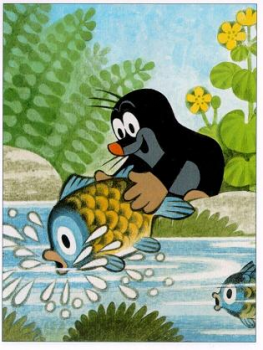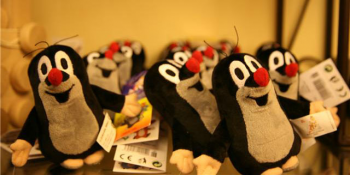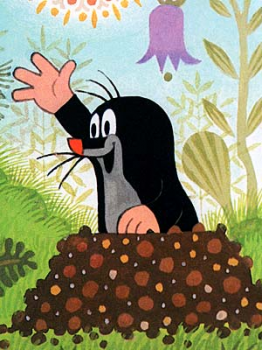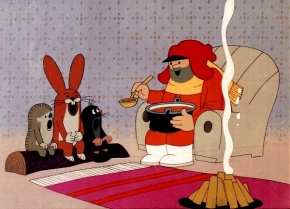The Lost World of Socialist Children’s TV
Anikó Imre / University of Southern California

Summer is a time of outdoor fun. Kids are finally released from their ruthless school and after-school schedules, and are free to run, swim, bike and hike all day. For working parents, however, high temperatures also tend to bring high anxiety. In reality, particularly in climates where it is just too darn hot to be outside between 10 and 5, kids are released to the world of Nintendo, Nickelodeon and Disney, where every air-conditioned summer morning is Saturday morning.
At the end of yet another long summer spent in the company of Spongebob and friends, the latest explosive blockbuster superheroes, and ever-proliferating Pokémon, I’ve decided to wear my parental hat over my scholarly hat for this column and compare my children’s television use with what I knew as a child. When it comes to guiding children in the contemporary media environment, searching one’s memories often appears to be not only an inevitable exercise but often the most reliable one. I am acutely aware of the risk of comparing then and now, them and my memory of me. Therefore, I will stop short of drawing any general ethical conclusions. Instead, what follows is largely a shameless indulgence in nostalgia, whose main purpose is to incite curiosity towards an almost-extinct children’s media culture that has barely been known outside of socialist Eastern Europe.
Socialist television of the 1970s was generally boring, censored and propagandistic, apart from some ritual, much-anticipated national variety and talent shows and the occasional US or Western European imports (The Flintstones, Charlie’s Angels, Bugs Bunny) deemed safe enough for the health of socialist citizens. Until the mid-1980s, when satellite and cable began to undermine the monopoly of state broadcasters, most viewers’ choices came down to turning the TV on or off. Children’s programming, however, was largely exempt from overt ideologies, apart from a general educational purpose and aesthetic quality. The latter was guaranteed by the fact that much of regional children’s animation was produced by artists banned from “serious” adult filmmaking. Kids’ TV was all PBS, for all ages. Animated films and television series, many of which were free of dialogue, were also easy to circulated within the bloc and thus constituted a shared transnational cultural register for children growing up in different parts of the Soviet empire.
The array of beloved characters and series is dazzling. I have chosen one of the most popular and enduring shows to highlight some of the features of this lost children’s television era: Krtek. While ethnographic studies of children’s media habits in 1970s-80s communist countries are not available, I have yet to talk to an East European over five who is not familiar with Krtek, the little mole, created by Czech animator Zdenek Miler in 1956, with an uninterrupted production of episodes from 1963 to 2000. The protagonist won himself enormous popularity in most East European countries, as well as Germany, Austria, and China. “Krtek” yields over 800 hits on YouTube; and a simple Google search turns up fan sites in German, Japanese, and most East European languages. Thanks to the regional Minimax network, along with the ancillary marketing of stuffed animals, books, DVDs, posters, toys and T-shirts, one bumps into Krtek virtually everywhere in the region.

It is hard to imagine a successful animated character on American children’s screens as unspectacular as The Little Mole and his friends, Rabbit and Hedgehog. These cartoons are characteristically economical, in aesthetics and content alike. Zdenek wanted his Krtek tales to cross borders with ease. For this reason, after the first, narrated episode, in subsequent ones he eclipsed dialogue altogether, including only exclamations and other noises. The simple stop-motion, hand-drawn cartoons call for an old-fashioned spectatorial sensibility and evoke a slower, smaller, more contemplative world. The characters’ power does not come from smart talk, physical abilities, frenzied Pixar motion or simple “cuteness.” Rather, one roots for them because of their ability to survive despite the odds. Their little lives in the shadows of greater enemies, such as people and machines, are precarious. But they appreciate the smallest pleasures, taking disappointment with patience and good humor. They are not troubled by oversized ambitions, the perpetual promise of growing big or making it big. Unlike Disney or most other American cartoons, which usually single out a character as the center of identification and afford it the dominant point of view, Krtek is more of a narrative tool to deliver an allegorical message about the community.
In the first and probably most memorable episode, “Jak krtek ke kalhotkám přišel” (“How the Mole Got His Pants”) released in 1956, the Little Mole, setting the horizon of the socialist citizen’s wishes appropriately humble, yearns for overalls with big pockets. The entire forest comes to his aid, each animal lending useful skills that turn flax into fabric, which is then cut and sewn into an attractive pair of overalls. I will never forget how impressed and satisfied I felt to see Krtek parade around in his entirely home-produced clothes. The episode provides a characteristic and, in retrospect, ironic lesson in sustainability, given the zeal with which public opinion and, to some extent, policy in the United States has recently begun to urge a shift to sustainable means of production and consumption, imposing this newly-found wisdom on the newly “wasteful” Third World.

Other episodes are even more openly critical of Stalinist bureaucratic modernity and mass consumerism alike, prefiguring the current global worry about the ecological impact of mass consumerism. The episode Mole in the Dream evokes the dystopia of the loss of electricity. A man survives the winter in his snowed-in house only with the help of the unbreakable endurance and spirit of the Mole and his little friends, the real East Europeans.

Mole in the City foreshadows environmental disaster: It begins with an army of machines relentlessly leveling the entire forest to make room for a row of soulless, identical housing blocks. All is left is a tree stump, on which Mole, Rabbit and Hedgehog huddle together. The bureaucrats try to compensate for the animals’ loss by assigning them an inflatable forest in an office. The three friends happily settle even for this until they accidentally puncture it. Like the actual people of Eastern Europe, have to make the best of grotesquely inadequate living conditions.
The child-adult viewer of these fairy tales is expected to identify with the displaced and oppressed, small, underground animal’s point of view. Monsters – from bulldozers to bureaucrats — are represented as purely external, alien, imposed. This is different from the point of view constructed by most American post-preschool children’s programming, which actively invite identification with the powerful at the same time as they often evoke a sense of ecological horror and guilt over causing extinction – an ambivalent viewpoint inscribed into American children’s positions within the global economy.
I introduced this rumination as an innocent trip down memory lane. I realize now that it is also a memorial to the Little Mole. As such, it does imply an ethical call to remember the particular children’s culture from which he sprung, which – unlike communist health care – wasn’t so bad after all. While there is clearly no going back, it might even allow us to imagine the possibility of a children’s media economy that is not entirely consumerist and advertisement-driven.
Image Credits:
1. Krtek the Mole
2. Krtek the doll
3. Krtek the Mole
4. Krtek and his friends
Please feel free to comment.
Aniko,
Thank you for your thoughtful treatment of this surprisingly important programming. I think you have identified the key elements of the series’ power – its simplicity, its ecological orientation, and the way in which it structures a viewer’s identification. I would simply add that it is enormously pleasurable to watch and listen to. The easy richness of the animation allows for appreciation on multiple levels, and it frequently mixes small doses of the fantastic alongside its more realist tendencies. Perhaps because I often find myself listening to an episode while my children watch intently, I especially appreciate the evocative nature of the soundtrack. The episode Mole and the Snowman (http://www.youtube.com/watch?v=cJzWNDNG4qY} features a nice example of the lovely soundtrack providing a very clear narrative without narration or dialogue. I think it is also worth emphasizing that creativity of this type appeals to young children even in our hyper-branded, hyper-speed era of children’s programming. Krtek has easily been the best loved video by my four year olds, who seem to much prefer this show’s pace and thoughtfulness to the intensity and affect of contemporary programming. I expect this will change in time, but for now I am pleased that Krtek is helping to ease their introduction to narrative and visual culture.
Daniel
Hi Daniel,
Thanks for confirming my sense about why this show — really just the tip of the iceberg of the treasures of socialist animation — is so unique and fun. I must ask how you access Krtek, since it’s not been distributed, let alone broadcast, in the US. But I’m so pleased to hear it has true international appeal.
Aniko
Hello Aniko,
You answered you own question in the article — YouTube. I know that this only provides access to a small portion of the produced material, but it is available easily enough, my kids can navigate the interface for themsleves, and it even streams to a mobile phone in a pinch.
Daniel
Hello,
I am coming late to this article but wanted to share my response. Through work and personal friendships I have often seen that the children of the 1970s raised throughout the Soviet world often bond today as they meet in places like London or Miami, over the same cartoons they watched as children. My Cuban husband often has Czech or Russian acquaintances in stitches with his renditions of Russian cartoon theme songs. This blog, set up for nostalgic Cubans living outside Cuba today, chronicles the Russian cartoons that were both the highlight and the burden of children’s programming for them: http://munequitosrusos.blogspot.com/ . I have also seen CDs burned full of downloaded cartoons and children’s songs, circulated between adults who grew up in different parts of the Soviet world. So I agree that Soviet children’s nostalgia is alive and well thanks to digital media technologies, and look forward to reading more analysis on this fun but important topic!
This is terribly late in coming, but I’d just add that another way titles circulate is from expats returning on trips/vacations and picking up beloved titles (like the Russian cartoon series known in Lithuania as NA PALAUK!) to bring back, often to share with their children (and their friends’ children…) The next problem is one of technology: getting Region 2 DVDs to play here in Region 1-land, but that ends up being not as difficult as the MPAA might wish!
hello,
though i’ve lived in belgium and germany all my life -i am now 44- i remember this mole fondly. krtek was broadcast by the public broadcasting company in belgium, the netherlands and germany together with a multitude of eastern european youth programs. so their impact wasn’t limited to eastern europe at all. we probably had the best of both worlds, growing up with all the hanna barbera and disney cartoons and series as well as eastern european, western european and australian series you can think of.
kind regards
ron
Hello,
I am very excited to tumble upon this article. I have a masters in animation from USC and I am Hungarian! I have written papers on Hungarian animation, but am always excited to discover others that are interested in the cold war era :) And now I watch Kisvakond with my own children. Maybe we can correspond in Hungarian if you wish, as hopefully you can see my email attached. I live in the LA area!
Kati
I stumbled upon this article. A very interesting read. Krtek had made it into the United States back in the early 1980’s on a show called “The Great Space Coaster”. I seen Krtek and the Rocket as a child, and mind you I watched Scooby Doo, Flinstones, G.I.Joe, Transformers, Robotech and so many other cartoons during those years, but Krtek was my favorite by far. I just never knew what the cartoon was called. I searched for him before the internet and no luck and gave up and forgot about him. Then in 2002 I married a czech and in 2003 made my way over to Czech Republic for my very first time, and precisely to my wife’s home city of Prague. Here in Prague while shopping for family and friends I noticed the little mole puppet on a shelf and almost knocked my wife and a few people over to go get it. At that point my wife said I was a bit teary eyed like finding an old lost friend. At that point I told her as a child I seen him on television in New York and fell in love with the cartoon wanting more over any other show. She told me she grew up watching him and through Krtek we bonded even more. I have 3 children here in the United States and all of them have grown up watching the little mole. Helps to have a region free dvd player to play Czech dvds. I still have that puppet of Krtek and my kids sleep with him all the time. Best part of all is you truly don’t need to know any language to understand the cartoon.
On a side note before I was born my father was in the US Army and served in the OSS (spy) and spoke German, Czech, Russian, Hungarian, Danish and French fluently cause of his father knew 11 languages and several dialects. back to my father, he spent plenty of time behind the iron curtain in Czechoslovakia and seen Krtek as well as the Russian Wolf cartoon and picked up a statue of the Wolf smoking. I had that for many years in my place. When I seen Krtek on TV for the first time, my father said he seen it when he first aired back in the 50’s. He too loved the mole. My father passed in 1991 so he never got the chance to meet my wife and kids and see the little mole again… Krtek is and always should be seen as a National Treasure of the Czech Republic and nothing short of that…
Robert
Great article but I did want to add that while growing up in Los Angeles in the late 1970s, ‘The Little Mole’ was actually broadcast on the local PBS affiliate. I recall how different it was from western cartoons, the slower pace and especially the beauty of the backgrounds. I was extremely fond of the show and it will be the first television program I’ll introduce to my son.
Hi y’all! Me too I’m terribly sorry for coming so late to this post. I trust someone can help me. We are an increasing group of Latinos in our 40’s-50’s who happen to have watched many Eastern European cartoons in our respective Latin American countries. Apart from the well-know Bolek i Lolek series, there was Professor Balthazar and many other cartoons. We need your help in order to find out what was the name and the country of a TV cartoon series for children featuring no dialogues but classical & middle-ages music instead and with its 2 main characters being a couple of bugs taking on somehow the roles Don Quixote (the grasshopper) & Sancho Panza (the beetle, though some fellow watchers contend it was a ladybug). They both traveled around many gardens & forests, having a thousand adventures with/against the ants, the bees, the flowers, etc. None of us seem to remember the name or the country, and I think I have thoroughly searched “the internets” for that specific children’s cartoon using Spanish, English, French, German and the google translator renditions into Eastern European languages. I have actually “harassed” some Polish friends, and according to them this cartoon wouldn’t be Polish. I have found no trace when searching former Yugoslavia, Hungary, former Czechoslovakia, or former USSR. I hope someone can help! I, for one, would just love to find the cartoon for myself and my children (when I have them) and offer it as a present for some of my friends’ children. Thanks a lot for any time anyone can devote to a better search I have performed!